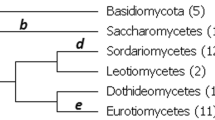The alignment of sets of sequences and the construction of phyletic trees: An integrated method (original) (raw)
Summary
In this paper we argue that the alignment of sets of sequences and the construction of phyletic trees cannot be treated separately. The concept of ‘good alignment’ is meaningless without reference to a phyletic tree, and the construction of phyletic trees presupposes alignment of the sequences.
We propose an integrated method that generates both an alignment of a set of sequences and a phyletic tree. In this method a putative tree is used to align the sequences and the alignment obtained is used to adjust the tree; this process is iterated. As a demonstration we apply the method to the analysis of the evolution of 5S rRNA sequences in prokaryotes.
Access this article
Subscribe and save
- Get 10 units per month
- Download Article/Chapter or eBook
- 1 Unit = 1 Article or 1 Chapter
- Cancel anytime Subscribe now
Buy Now
Price excludes VAT (USA)
Tax calculation will be finalised during checkout.
Instant access to the full article PDF.
Similar content being viewed by others

Inferring Trees
Chapter © 2017
References
- Blanken RL, Klotz LC, Hinnebusch AG (1982) Computer comparison of new and existing criteria for constructing evolutionary trees from sequence data. J Mol Evol 19:9–19
PubMed Google Scholar - Chou FE, Fasman GD (1978) Prediction of secondary structure of proteins from their amino acid sequence. Adv Enzyol. 47:145–148
Google Scholar - Cornish-Bowden A (1983) Phenetic methods of classification use information discarded by minimum length methods. J Theor Biol 101:317–319
Article Google Scholar - Dayhoff MO (1976) Atlas of protein structure, vol 5, suppl 2. National Biochemical Research Foundation, Washington, DC
Google Scholar - Fitch WM, Yasunobu KT (1974) Phylogenies from amino acid sequences aligned with gaps: the problem of gap weighting. J Mol Evol 5:1–24
Article Google Scholar - Fox GE, Woese CR (1975) 5S RNA secondary structure. Nature 256:505–507
Google Scholar - Fox GE, Stackebrandt RB, Hespell RB, Gibson J, Maniloff J, Dyer TA, Wolfe RS, Balch WE, Tanner RS, Magrum LJ, Zablen LB Blakemore R, Gupta R, Bonen L, Lewis BJ, Stahl DA, Luehrsen KR, Chen KN, Woese CR (1980) The phylogeny of prokaryotes. Science 209:457–463
PubMed Google Scholar - Hogeweg P (1976a) Iterative character weighting in numerical taxonomy. Comput Biol Med 6:166–211
Article Google Scholar - Hogeweg P (1976b) Topics in biological pattern analysis. Thesis, RU Utrecht
- Hogeweg P, Hesper B (1972) BIOPAT, program system for bioinformatic pattern analysis. Bioinformatica, Utrecht
Google Scholar - Hogeweg P, Hesper B (1981) Oligothetic characterisation of clusters. Pattern Recognition 14:131–136
Article Google Scholar - Hori H, Osawa S (1979) Evolutionary change in 5S RNA secondary structure and a phylogenetic tree of 54 5S RNA species. Proc Natl Acad Sci USA 16:381–385
Google Scholar - Klotz LC, Blanken RL (1981) A practical method for calculating evolutionary trees from sequence data. J Theor Biol 91:216–272
Article Google Scholar - Klotz LC, Komar N, Blanken RL, Mitchell RM (1979) Calculation of evolutionary trees from sequence data. Proc Natl Acad Sci USA 76:4516
PubMed Google Scholar - Kuntzel H, Heidrich M, Piechulla B (1981) Phylogenetic tree derived from bacterial, cytosol and organelle 5 S rRNA sequences. Nucleic Acids Res 9:1451–1461
PubMed Google Scholar - Leenhouts PW (1968) A guide to herbarium taxonomy. IAPT, Utrecht (Regnum vegetabile, vol 58)
Google Scholar - McLachlan AD (1971) Tests for comparing related amino acid sequences. Cytochrome c and Cytochrome c551. J Mol Biol 61:409–424
Article PubMed Google Scholar - McNeill J (1978) Purposeful phenetics. Syst Zool 28:465–482
Google Scholar - Needleman SB, Wunsch CD (1970) A general method applicable to the search for similarities in the amino acid sequences of two proteins. J Mol Biol 48:443–453
Article PubMed Google Scholar - Nei M, Tajima F, Tateno Y (1983) Accuracy of estimated phylogenetic trees from molecular data II. Gene frequency data. J Mol Evol 19:153–170
PubMed Google Scholar - Sankoff RJ, Cedergren RJ, McKay W (1982) A strategy for sequence phylogeny research. Nucleic Acids Res 10:421–431
PubMed Google Scholar - Schwartz RM, Dayhoff MO (1978) Origins of Prokaryotes, Eukaryotes, Mitochondria and Chloroplasts: a perspective is derived from protein and nucleic acid sequence data. Science 199:395–403
PubMed Google Scholar - Sellars PH (1974) On the theory and computation of evolutionary distances. SIAM J Appl Math 26:787–793
Article Google Scholar - Smith TF, Waterman MS, Fitch WM (1981) Comparative biosequence metrics, J Mol Evol 18:38–46
Article PubMed Google Scholar - Sneath HA, Sokal RR (1973) Numerical taxonomy. WH Freeman, San Francisco, London
Google Scholar - Tateno Y, Nei M, Tajima F (1982) Accuracy of estimated phylogenetic trees from molecular data I. Distantly related species. J Mol Evol 18:387–404
Article PubMed Google Scholar - Waterman MS, Smith TF, Beyer WA (1976) Some biological sequence metrics. Adv Math 20:267–287
Article Google Scholar
Author information
Authors and Affiliations
- Bioinformatica, Padualaan 8, Utrecht, The Netherlands
P. Hogeweg & B. Hesper
Authors
- P. Hogeweg
You can also search for this author inPubMed Google Scholar - B. Hesper
You can also search for this author inPubMed Google Scholar
Rights and permissions
About this article
Cite this article
Hogeweg, P., Hesper, B. The alignment of sets of sequences and the construction of phyletic trees: An integrated method.J Mol Evol 20, 175–186 (1984). https://doi.org/10.1007/BF02257378
- Received: 26 September 1983
- Revised: 14 January 1984
- Issue Date: June 1984
- DOI: https://doi.org/10.1007/BF02257378

